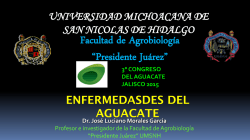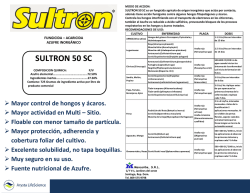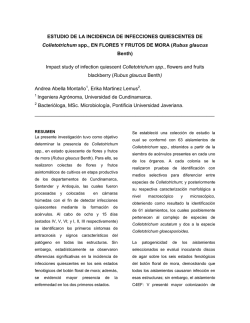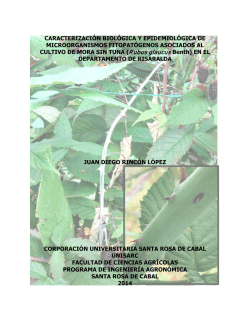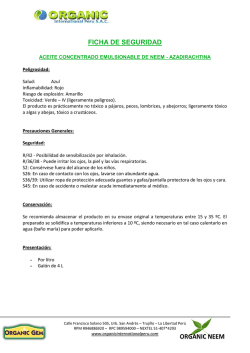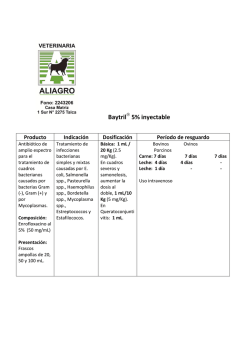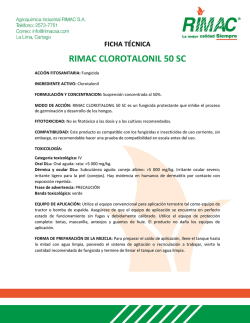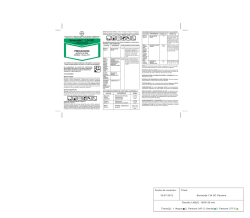
Descargar el archivo PDF - Revista Mexicana de Ciencias Agrícolas
Revista Mexicana de Ciencias Agrícolas Vol.7 Núm.5 30 de junio - 13 de agosto, 2016 p. 1189-1198 Alternativas para el control de Colletotrichum spp.* Alternatives for the control of Colletotrichum spp. Nadia Landero-Valenzuela1, Francisco Marcelo Lara-Viveros1§, Petra Andrade-Hoyos1, Luis Alfonso Aguilar-Pérez2 y Graciano Javier Aguado Rodríguez1 Departamento de Postgrado- Universidad Politécnica de Francisco I. Madero. Domicilio conocido Tepatepec, Hidalgo. C. P. 42660. ([email protected], fmlaravi@ conacyt.mx, [email protected], [email protected]). 2Postgrado en Fitopatología-Colegio de Postgraduados. Carretera México-Texcoco, Montecillo, Texcoco, km 36.5, Estado de México. C. P. 56230. ([email protected]). §Autor para correspondencia: [email protected]. 1 Resumen Abstract Colletotrichum gloeosporioides es un patógeno que causa una enfermedad conocida como antracnosis, la cual se presenta en plantas y frutos. El fruto desde su formación y desarrollo en la planta, y hasta la poscosecha sufre daños por este patógeno, ocasionando pérdidas hasta de 100%, dependiendo de las condiciones climáticas que prevalezcan en una región. Los fungicidas en precosecha o poscosecha constituyen la principal forma de reducir las pérdidas por esta enfermedad. Sin embargo, el uso indiscriminado de éstos ha tenido como consecuencia la resistencia de los microorganismos patógenos. Por otro lado, su uso está ampliamente restringido debido a la preocupación por los residuos tóxicos y los riesgos ocasionados a la salud. Por ello, existe la necesidad de manejar la enfermedad con alternativas amigables con el medio ambiente, entre ellas los extractos de plantas, los microorganismos como agentes de control biológico, tratamientos hidrotérmicos, manipulación genética y resistencia inducida. El objetivo del presente trabajo fue analizar las diferentes alternativas de control aplicadas al manejo de Colletotrichum spp. Colletotrichum gloeosporioides is a pathogen that causes a disease known as anthracnose, which occurs in plants and fruits. The fruit from their training and development on the ground, and even post-harvest is damaged by this pathogen, causing losses of up to 100%, depending on weather conditions prevailing in a region. Fungicides preharvest or postharvest are the main way to reduce losses from this disease. However, indiscriminate use of these has resulted in resistance of pathogenic microorganisms. On the other hand, its use is largely restricted due to concerns about toxic waste and the risks posed to health. Therefore, there is a need to manage the disease friendly alternatives with the environment, including plant extracts, microorganisms as biological control agents, hydrothermal treatments, genetic manipulation and induced resistance. The aim of this study was to analyze the different alternatives applied to the management control of Colletotrichum spp. Palabras clave: Trichoderma, antracnosis, control biológico, hospedantes, poscosecha. Keywords: Trichoderma, anthracnose, biological control, hosts, postharvest. * Recibido: abril de 2016 Aceptado: junio de 2016 Nadia Landero-Valenzuela et al. 1190 Rev. Mex. Cienc. Agríc. Vol.7 Núm. 5 30 de junio - 13 de agosto, 2016 Introducción Introduction Colletotrichum es un hongo de distribución cosmopolita y con predominancia en las regiones tropicales y subtropicales (Xiao et al., 2004). Comprende principalmente patógenos de plantas y frutos, incluye a más de 100 especies responsables de causar la antracnosis, por tal motivo es esencial identificar las especies para mejorar el control de la enfermedad (Crounch et al., 2014). Colletotrichum gloeosporioides es considerada como la especie más desafiante de resolver, comprende la gama de huéspedes más amplia de todas las especies de Colletotrichum (Du et al. 2005; Prabhakaran, 2010). Colletotrichum is a fungus is a cosmopolitan distribution and predominantly in tropical and subtropical regions (Xiao et al., 2004). Mainly it comprises pathogens of plants and fruits, including more than 100 species responsible for causing anthracnose, for this reason it is essential to identify the species to improve control of the disease (Crounch et al., 2014). Colletotrichum gloeosporioides is considered the most challenging kind of resolve, includes the widest range of guests of all species of Colletotrichum (Du et al., 2005; Prabhakaran, 2010). En la Figura 1A podemos observar los síntomas en chile pimiento morrón (Capsicum annuum var. annuum) y en la Figura 1B y C se aprecian los frutos de carambola (Averrhoa carambola L.) y mango (Mangifera indica L.) con los síntomas típicos de la enfermedad; la Figura 2A muestra los síntomas de antracnosis en el fruto de papaya (Carica papaya L.), otras especies afectadas son banano (Musa paradisiaca L.), café (Coffea arabica L.), aguacate (Persea americana Mill.), gandul (Cajanus cajan L. Mill sp.), fresa (Fragaria vesca L.), manzana (Malus domestica Borkh.), almendra (Prunus dulcis Mill.) y chirimoya (Annonna cherimola Mill.); en ornamentales como las violetas (Viola odorata L.), orquídeas (orchidaceae) de diferentes géneros y especies, lluvia de oro (Cassia fistula L.); otras plantas como soja (Glycine max (L.) Merr.), menta (Menta piperita L.), lenteja (Lens culinaris L.) y algodón (Gossipium hirsutum L.) (Freeman et al., 2001; Freeman, 2008); ésta misma especie puede causar elevadas pérdidas de los frutos en poscosecha (Gomes et al., 2013). In Figure 1A we see the symptoms in green pepper (Capsicum annuum var. annuum) and Figure 1B and C are appreciated fruit of start fruit (Averrhoa carambola L.) and mango (Mangifera indica L.) with typical symptoms of the disease; Figure 2A shows the symptoms of anthracnose in the fruit of papaya (Carica papaya L.), other affected species are banana (Musa paradisiaca L.), coffee (Coffea arabica L.), avocado (Persea americana Mill.), pigeon pea (Cajanus cajan L. Mill sp.), strawberry (Fragaria vesca L.), apple (Malus domestica Borkh.), almond (Prunus dulcis Mill.) and cherimoya (Annonna cherimola Mill.); ornamentals such as violets (Viola odorata L.), orchids (Orchidaceae) from different genera and species, golden shower (Cassia fistula L.); other plants such as soybean (Glycine max (L.) Merr.), peppermint (Menta piperita L.), lentil (Lens culinaris L.) and cotton (Gossipium hirsutum L.) (Freeman et al., 2001; Freeman, 2008); this species can cause high losses of fruits in postharvest (Gomes et al., 2013). Actualmente las alternativas de control para Colletotrichum spp. son variadas debido a que la estrategia más común, los plaguicidas, han causado resistencia en los organismos patógenos. Entre los métodos de control del patógeno en precosecha y poscosecha se encuentran el uso de aire caliente, tratamientos hidrotérmicos, atmósferas modificadas (Karabulut y Baykal, 2004; Gutiérrez et al., 2004; Ragazzo et al., 2015), luz ultravioleta, ozono (Cia et al., 2009 ), extractos de plantas (Bautista-Baños et al., 2003) y microorganismos agentes de control biológico que actúan como antagonismo contra diversos patógenos como Rodhotorula minuta, Bacillus subtilis, Trichoderma spp., por mencionar algunos (Janisiewics y Korsten, 2002; Spadaro y Gullino, 2004; Pérez, 2006; Vos et al., 2014). A) B) C) Figura. 1. Síntoma de antracnosis causado por Colletotrichum gloeosporioides, inoculado en A) chile morrón Capsicum annuum var. annuum; B) carambola (Averrhoa carambola L.); y C) mango (Mangifera indica L.). Figure. 1. Symptom anthracnose caused by Colletotrichum gloeosporioides inoculated in A) green pepper Capsicum annuum var. annuum; B) star fruit (Averrhoa carambola L.); and C) mango (Mangifera indica L.). 1191 Alternativas para el control de Colletotrichum spp. Bioracionales en contra de Colletotrichum gloeosporioides. En la actualidad, los productos naturales gozan de amplia aceptación y reemplazan cada vez más a los productos sintéticos o materiales generados artificialmente. Como respuesta a esta tendencia se ha producido un creciente interés en la investigación de la posible utilización de aceites esenciales, extractos de plantas, entre otros. Por lo anterior, una alternativa al uso de moléculas químicas sintéticas para el control de organismos dañinos en la agricultura es la aplicación de biorracionales, los cuales son definidos como sustancias producidas por microorganismos, plantas o minerales, que se descomponen en pocas horas después de aplicarlos y son específicos para el organismo que se desea controlar (O’Farril, 2008). Respecto al uso de plantas con propiedades antimicrobiales, Lara et al. (2014) encontraron que los glucosinolatos aislados de floretes de brócoli a concentraciones de 1.54 y 0.92 µg/ µL-1 inhibieron en su totalidad la germinación de esporas de Colletotrichum gloesporioides aislado de mango (Mangifera indica L.). Extracto de raíces de Gliricida sepium contra C. gloeosporioides fue probado reduciendo la severidad de la antracnosis 94% sobre frutos de papaya Hawaiana en poscosecha, mientras que el testigo químico la redujo 84% (Loaiza y Rivera, 2000). Otro extracto que se ha utilizado para control de C. gloeosporioides en papaya en poscosecha es de semilla de este mismo fruto, solo y mezclado con quitosano, inhibiendo este último el crecimiento micelial de C. gloeosporioides a concentraciones de 2.5 y 3%. Los resultados in vivo demostraron que a una concentración de 1.5% de quitosano, la severidad fue de 1% (Bautista-Baños et al., 2003). A) B) C) Figura 2. Colletotrichum gloeosporioides A) Fruto de papaya con antracnosis causada por Colletotrichum gloeosporioides; B) Colletotrichum gloeosporioides. creciendo en medio de cultivo PDA; C) Esporas de Colletotrichum gloeosporioides. Figure 2. Colletotrichum gloeosporioides A) Papaya fruit with anthracnose caused by Colletotrichum gloeosporioides; B) Colletotrichum gloeosporioides. Growing PDA culture medium; C) spores Colletotrichum gloeosporioides. Lo anterior demuestra que el quitosano tiene potencial fúngico en contra de diferentes patógenos que pertenecen al reino fungi, lo cual se debe a que posee carga policatiónica, mientras que las paredes de los hongos poseen carga negativa desactivando la germinación de las esporas de Botryosphaeria parva y C. gloesporioides (Everett et al., 2005). Currently control alternatives for Colletotrichum spp. they are varied because the most common strategy, pesticides, have caused resistance in pathogenic organisms. Methods of control of the pathogen in preharvest and postharvest are using hot air, hydrothermal treatments, modified atmospheres (Karabulut and Baykal, 2004; Gutiérrez et al., 2004; Ragazzo et al., 2015), ultraviolet light, ozone (Cia et al., 2009), plant extracts (Bautista-Baños et al., 2003) and micro-biological control agents that act as antagonism against various pathogens such as Rodhotorula minuta, Bacillus subtilis, Trichoderma spp., to name a few (Janisiewics and Korsten, 2002; Spadaro and Gullino, 2004; Pérez, 2006; Vos et al., 2014). Otro de los bioracionales a utilizar son los aceites esenciales de diversas especies de plantas con propiedades antimicrobiales, estos afectan el desarrollo de hongos tanto in vitro como in vivo de productos hortícolas (Molina et al., 2010). Una de estas especies es Thyme vulgaris L., cuyo aceite esencial se ha encontrado que es antibacterial y antifúngico, ensayado sobre varios microorganismos patógenos (Hammer et al., 1999; Vanneste y Boyd, 2002; Rassooli y Mirmostafa, 2003; Yang y Clausen, 2007). Biorational against Colletotrichum gloeosporioides. At present, natural products are widely accepted and increasingly replacing synthetic products or materials generated artificially. In response to this trend it has been a growing interest in investigating the possible use of essential oils, plant extracts and others. Therefore, an alternative to the use of synthetic chemical molecules to control harmful organisms in agriculture is the application of biorationals, which are defined as produced by microorganisms, plants 1192 Rev. Mex. Cienc. Agríc. Vol.7 Núm. 5 30 de junio - 13 de agosto, 2016 Cuando se ensayó la efectividad biológica del aceite en contra de C. gloeosporioides aislado de papaya en poscosecha tuvo un efecto fungicida, el desarrollo del hongo se vio reducido a medida que las concentraciones aumentaron (Molina et al., 2010). De manera similar Landero et al. (2013) encontraron que el aceite de canela tuvo un mejor efecto en la inhibición micelial cuando las concentraciones aumentaron; sin embargo, estas fueron bajas (0.0015, 0.0025 y 0.005%) comparadas con el extracto de ajo que inhibió 100% del desarrollo del hongo cuando utilizó 10% de concentración del mismo. Lo anterior indica que debido a la efectividad de los aceites utilizados a bajas concentraciones podrían considerarse con mayor potencial para uso promisorio a nivel comercial. Control biológico de Colletotrichum gloeosporioides. El control biológico de antracnosis ha sido reportado en manzanas (Janisiewicz et al., 2003), papaya (Gamagae et al., 2004), aguacate (Korsten et al., 1995) y mango (Carillo et al., 2005). La mayor parte de los experimentos de control biológico en enfermedades poscosecha se han realizado aplicando los antagonistas en condiciones controladas de humedad y temperatura. Pocos trabajos se han realizado con aplicación de microorganismos en condiciones de campo, en donde la efectividad de los antagonistas es afectada por otros factores, como cambios de temperatura, humedad, luz ultravioleta e interacción con otros microorganismos. Paradójicamente uno de los mayores obstáculos para el desarrollo del control biológico en poscosecha es su relativa inhabilidad para controlar infecciones establecidas en precosecha, como son las infecciones latentes (Spadaro y Gullino, 2004). Sin embargo, Ippolito y Nigro (2000) afirman que la aplicación en campo de los agentes de control biológico puede propiciar la colonización de la superficie del fruto y prevenir el establecimiento de infecciones latentes en los frutos de la huerta productora. En antracnosis de mango, Juárez (2001) reportó una extensiva búsqueda de microorganismos antagonistas al agente causal de esta enfermedad, donde se aislaron 120 cepas (5 levaduras y 115 bacterias) de la filósfera de mango, de las cuales dos cepas, una bacteria (Bacillus subtilis) y una levadura (Rodhotorula minuta) fueron las que presentaron mayor actividad antagonista en ensayos in vitro contra C. gloeosporioides. Por su parte, Baños-Guevara et al. (2003) empleó bacterias antagonistas y extractos de plantas con propiedades fungitóxicas, para evaluar los efectos de la antracnosis sobre algunas características físicas, químicas y fisiológicas de frutos de papaya Maradol roja. Los resultados mostraron que Nadia Landero-Valenzuela et al. or minerals, which decompose within a few hours after application and they are specific for the organism to be controlled (O’Farril, 2008). Regarding the use of plants with antimicrobial properties, Lara et al. (2014) found that glucosinolates broccoli florets isolated at concentrations of 1.54 and 0.92 µg/ µL-1 fully inhibited spore germination of Colletotrichum gloesporioides isolated from mango (Mangifera indica L.). The Gliricida sepium root extract against C. gloeosporioides was tested by reducing the severity of anthracnose on fruits 94% in Hawaiian papaya in postharvest chemical control while the reduced 84% (Loaiza and Rivera, 2000). Another extract has been used to control in papaya C. gloeosporioides postharvest seed it is the same fruit, alone and mixed with chitosan, the latter inhibiting mycelial growth of C. gloeosporioides at concentrations of 2.5 and 3%. The in vivo results showed that at a concentration of 1.5% chitosan, the severity was 1% (Bautista-Baños et al., 2003). This shows that the chitosan has fungal potential against different pathogens belonging to the fungi kingdom, which is due to having polycationic load, while the walls of fungi are negatively charged deactivating germinating spores Botryosphaeria parva and C. gloesporioides (Everett et al., 2005). Another biorational to use are plant extracts and essential oils of various plant species with antimicrobial properties, they affect the development of fungi both in vitro and in vivo of horticultural products (Molina et al., 2010). One of these species is Thyme vulgaris L., which has been found essential oil antibacterial and antifungal is, tested on several pathogenic microorganisms (Hammer et al., 1999; Vanneste and Boyd, 2002; Rassooli and Mirmostafa, 2003; Yang and Clausen, 2007). When the biological effectiveness of the oil was tested against C. gloeosporioides isolated from papaya postharvest had a fungicidal effect, the development of the fungus was reduced as concentrations increased (Molina et al., 2010). Similarly Landero et al. (2013) found that cinnamon oil had a better effect on mycelial inhibition when increased concentrations; however, these were low (0.0015, 0.0025 and 0.005%) compared with garlic extract that inhibited 100% of fungal growth when used 10% concentration. This indicates that due to the effectiveness of the oils used at low concentrations could be considered more promising potential for use commercially. 1193 Alternativas para el control de Colletotrichum spp. dos cepas de B. firmus y cuatro de Pseudomonas fluorescens redujeron in vitro el crecimiento de C. gloeosporioides. Algunos ejemplos de microorganismos antagonistas utilizados exitosamente para controlar enfermedades en poscosecha son: B. licheniformis contra C. gloeosporioides en mango (Govender et al., 2005). Trichoderma spp. (Figura 3 A, B, C, D, E y F) es considerado el antagonista más estudiado para el control de fitopatógenos. Infante et al. (2009) estudiaron y realizaron un resumen sobre los modos de acción. En la integración de los resultados mencionaron que los mecanismos de acción que permiten el control de patógenos a Trichoderma spp., se encuentra la competencia por el sustrato, parasitismo (Figura 3 A, B, C, D y F), antibiosis, desactivación de enzimas del patógeno, penetración (Figura 3F) y resistencia inducida, principalmente. Biological control of Colletotrichum gloeosporioides. The biological control of anthracnose has been reported in apples (Janisiewicz et al., 2003), papaya (Gamagae et al., 2004), avocado (Korsten et al., 1995) and handle (Carillo et al., 2005). Most of the experiments postharvest biocontrol diseases were made by using the antagonists in controlled conditions of humidity and temperature. Few studies has been done with application of microorganisms under field conditions, where the effectiveness of the antagonists is affected by other factors such as changes in temperature, humidity, ultraviolet light and interaction with other microorganisms. Paradoxically, one of the biggest obstacles to the development of biological control in postharvest is its relative inability to control preharvest established infections, such as latent infections (Spadaro and Gullino, 2004). However, Ippolito and Nigro (2000) state that the application in the field of biological control A) B) C) D) E) F) Figura 3. Colletotrichum gloeosporioides, hifa interactuando con A) Trichoderma viride; B) Trichoderma longibrachiatum; C) Trichoderma asperellum 1; D) Trichoderma asperellum 2; E) y F) Trichoderma harzianum parasitando, lisando o deformando el micelio de Colletotrichum gloeosporioides. Las flechas rojas indican las hifas de Colletotrichum, las flechas negras indican las hifas de Trichoderma. Figure 3. Colletotrichum gloeosporioides, hyphae interacting with A) Trichoderma viride; B) Trichoderma longibrachiatum; C) Trichoderma asperellum 1; D) Trichoderma asperellum 2; E) and F) Trichoderma harzianum parasitizing, lysing or deforming the mycelium of Colletotrichum gloeosporioides. Red arrows indicate the hyphae of Colletotrichum, black arrows indicate the hyphae of Trichoderma. Control de Colletotrichum spp. a través de la manipulación molecular. La manipulación de genes a través de técnicas de ingeniería genética ha permitido disminuir la síntesis de etileno, considerada la hormona de la madurez en especies vegetales, Colletotrichum spp., se desarrolla en el fruto precisamente cuando este inicia su maduración. Con la finalidad de disminuir la síntesis de etileno se han llevado a cabo trabajos donde se desarrollaron plantas a las cuales se les ha silenciado los genes ACC oxidasa mostrando agents can lead to the colonization of the fruit surface and prevent the establishment of latent infections in producing the fruits of the orchard. In anthracnose of mango, Juárez (2001) reported an extensive search of antagonistic microorganisms to the causative agent of this disease, where 120 strains were isolated (5 yeast and 115 bacteria) of the phyllosphere mango, of which two strains, a bacterium (Bacillus subtilis) 1194 Rev. Mex. Cienc. Agríc. Vol.7 Núm. 5 30 de junio - 13 de agosto, 2016 diversas alteraciones (Wi y Park, 2002). Frutos en poscosecha también han sido sometidos a este tipo de técnicas, retrasando la madurez en el caso del jitomate, además de detener la descomposición debida a la presencia de C. gloeosporioides, cuya infección estuvo detenida hasta la aplicación de etileno externo (Cooper et al., 1998). Otra especie a la cual se le han silenciado exitosamente un gran número de genes es Nicotiana benthamiana (Robertson, 2004) que también es susceptible a infección por Colletotrichum orbicularie (Shen et al., 2001). Las principales fuentes de resistencia a antracnosis han sido identificadas en Capsicum baccatum L. y C. chinense Jacq. Por el Centro de Desarrollo e Investigación Asiática de Vegetales en 1999, y los investigadores han usado estas fuentes para estudiar la herencia de la resistencia a antracnosis (Pakdeevaraporn et al., 2005; Kim et al., 2010; Lee et al., 2010. Análisis genéticos de poblaciones segregantes mostraron que los patrones de herencia de la resistencia varían dependiendo de la especie y aislamiento de Colletotrichum, la fuente de la resistencia, y también la etapa de madurez del fruto. Considerando a Colletotrichum acutatum, la resistencia provino de C. chinense ‘PBC932’ en la línea ’0038-9155’. El patógeno fue controlado por dos genes dominantes complementarios en frutos verdes, pero dos genes recesivos en frutos rojos (Lin et al., 2007). Colletotrichum capsici ha sido otra de las especies sobre las cuales se ha trabajado para su control, debido a que puede causar pérdidas poscosechas hasta de 30% (Lakshmesha et al. (2002). Por ello, Lakshmesha et al. (2007) redujo la actividad de celulasa (42.86%) y pectinasa (40%) de este patógeno, exponiendo durante tres días el micelio maduro bajo rayos ultravioleta (312 nm de longitud de onda a una distancia de 12 pulgadas) durante diferentes tiempo, encontrando que a 45 min de exposición C. capsici fue menos virulento. La reducción en la actividad de las enzimas resultó en 3.5 días de retraso en la manifestación de la antracnosis. Para el caso específico de chile maduro en interacción con C. gloeosporioides se encontró que el gen esterasa de chile (PepEST) es altamente expresable durante interacciones incompatibles, así como que la expresión del gen es específica para el fruto en respuesta a la inoculación del patógeno, además puede ser regulada por heridos y tratamientos con ácido jasmónico durante la maduración. Esta expresión de genes PepEST no se presenta en frutos sin madurar (Ko et al., 2005). Inductores de resistencia a Colletotrichum spp. Actualmente la inducción de resistencia a patógenos en frutos cosechados usando elicitores, físicos, químicos y biológicos está pasando Nadia Landero-Valenzuela et al. and a yeast (Rodhotorula minuta) were those that showed higher antagonistic activity in vitro assays against C. gloeosporioides. Meanwhile, Baños-Guevara et al. (2003) used antagonistic bacteria and plant extracts with fungitoxic properties, to evaluate the effects of anthracnose on some physical, chemical and physiological characteristics of papaya fruit red Maradol. The results showed that two strains B. firmus and four Pseudomonas fluorescens reduced growth in vitro of C. gloeosporioides. Examples of antagonistic microorganisms used successfully to control postharvest diseases are: B. licheniformis against C. gloeosporioides in mango (Govender et al., 2005). Trichoderma spp. (Figure 3 A, B, C, D, E and F) is considered the most studied antagonist for the control of phytopathogenic. Infante et al. (2009) studied and made a summary of the modes of action. The integration of the results mentioned that the mechanisms of action that allow control of pathogens Trichoderma spp., competition is the substrate, parasitism (Figure 3 A, B, C, D and F), antibioses, disabling enzymes pathogen penetration (Figure 3F) and induced resistance, mainly. Colletotrichum spp. control through molecular manipulation. The manipulation of genes by genetic engineering techniques has reduced ethylene synthesis, hormone considered maturity in plant species, Colletotrichum spp. Develops in the fruit precisely when it begins its maturation. In order to decrease the synthesis of ethylene they were carried out work where plants were developed which have been silenced them the ACC oxidase genes showing various alterations (Wi and Park, 2002). Fruits in postharvest also have been subjected to these techniques, delaying maturity in the case of tomatoes, in addition to stop the decomposition due to the presence of C. gloeosporioides, whose infection was detained until the application of external ethylene (Cooper et al., 1998). Another species to which it successfully silenced many genes is Nicotiana benthamiana (Robertson, 2004) which is also susceptible to infection by Colletotrichum orbicularie (Shen et al., 2001). The main sources of resistance to anthracnose have been identified in Capsicum baccatum L. and C. chinense Jacq. By the Centre for Development and Asian Vegetable Research in 1999, and researchers have used these sources to study the inheritance of resistance to anthracnose (Pakdeevaraporn et al., 2005; Kim et al., 2010; Lee et al., 2010). Genetic analysis Alternativas para el control de Colletotrichum spp. a ser un enfoque prometedor para controlar enfermedades postcosecha como una alternativa a los fungicidas (Terry y Joyce, 2004). El ácido β-aminobutirico no proteíco (BABA), un raro compuesto encontrado en la naturaleza, se ha mostrado que induce resistencia en contra de un amplio rango de organismos patógenos, incluyendo hongos, virus, bacterias y nematodos en plantas (Zimmerli et al., 2001; Cohen, 2002; Van der Ent et al., 2009; Quaglia et al., 2011). Otros inductores que han sido probados en contra de C. gloeosporioides son ácido salicílico, ácido 2,6-dicloroisonicotinico, ácido benzo1,2,3-tiadiazole-7-carbotioico S metil ester y ácido jasmónico, encontrándose que ácido salicílico a una concentración de 1 mM sobre frutos inmaduros de chile no se presentaron síntomas de la enfermedad, al igual que en frutos maduros sin tratar (Lee et al., 2009) etapa en la cual la resistencia a fitopatógenos incrementa (Oh et al., 1999). Conclusiones La principal forma de control de Colletotrichum spp., es a través del uso de productos químicos sintéticos. La resistencia a los fungicidas y la presión regulatoria respecto a residuos de pesticidas y la preocupación por la salud humana están en aumento. Los productos biorracionales como son los extractos vegetales son productos naturales que han aumentado su importancia y aplicación en las últimas tres décadas, no como una moda, sino por el conocimiento de sus propiedades químicas, necesarias para defenderse eficientemente de microorganismos e insectos, propiedades que el hombre ha aprovechado para su beneficio, sin verse afectado negativamente el ambiente. Otra de las alternativas son los biofungicidas, ampliamente estudiados, han demostrado ser compatibles con otros productos, así como operar a través de una amplia variedad de mecanismos. En lo que respecta a la compatibilidad de microorganismos benéficos con otros productos es limitada, así tenemos para el caso de hongos biofungicidas que solo toleran la mezcla con ciertos fungicidas químicos sintéticos, es necesario que el productor conozca los diferentes grupos químicos a los que pertenecen los fungicidas y poder hacer uso eficaz y eficiente de los biofungicidas. Los inductores de defensa de la planta han demostrado ser eficaces en la supresión de Colletotrichum spp., tanto por sí solos como en combinación con otros productos. 1195 of segregating populations showed that the patterns of inheritance of resistance vary depending on the species and isolation of Colletotrichum, the source of resistance, and also the stage of maturity of the fruit. Considering Colletotrichum acutatum, the resistance came from C. chinense 'PBC932' in línea '0038-9155 '. The pathogen was controlled by two complementary dominant genes in green fruits, but two recessive genes in red fruits (Lin et al., 2007). Colletotrichum capsici was another species on which has worked to control it, because it can cause postharvest losses up to 30% (Lakshmesha et al. (2002). Therefore, Lakshmesha et al. (2007) reduced cellulase activity (42.86%) and pectinase (40%) of this pathogen, exposing for three days the mature mycelia under ultraviolet (312 nm wavelength at a distance of 12 inches) during different time, finding that 45 min C. capsici exposure was less virulent. the reduction in the activity of enzymes resulted in 3.5 days late in the manifestation of anthracnose. for the specific case of mature chili interaction with C. gloeosporioides was found that the esterase gene chile (PepEST) is highly expressible during incompatible interactions and the gene expression is specific to the fruit in response to pathogen inoculation also can be regulated by injuries and treatment with jasmonic acid during ripening. This expression of genes PepEST not present in unripe fruits (Ko et al., 2005). Inducers of resistance to Colletotrichum spp. Currently the induction of resistance to pathogens in fruits harvested using elicitors, physical, chemical and biological is becoming a promising approach to control postharvest diseases as an alternative to fungicides (Terry and Joyce, 2004). The non-proteinaceous β-aminobutyric acid (BABA), a rare compound found in nature, has been shown to induce resistance against a wide range of pathogenic organisms, including fungi, viruses, bacteria and nematodes in plants (Zimmerli et al., 2001; Cohen, 2002; Van der Ent et al., 2009; Quaglia et al., 2011). Other inducers that have been tested against C. gloeosporioides are salicylic acid, 2,6-dichloroisonicotinic acid, benzo1,2,3-tiadiazole-7-carbothioic acid S methyl ester and jasmonic acid, salicylic acid was found that a concentration of 1 mM on immature fruits of pepper no disease symptoms presented, as in mature fruits untreated (Lee et al., 2009) stage in which the resistance to phytopathogenic increases (Oh et al., 1999) . Nadia Landero-Valenzuela et al. 1196 Rev. Mex. Cienc. Agríc. Vol.7 Núm. 5 30 de junio - 13 de agosto, 2016 La manipulación genética constituye una de las alternativas más viables en la actualidad; sin embargo, es una estrategia cara que requiere de mayor conocimiento para considerarla segura, además, la obtención de un producto manipulado puede tardar años en lograrse, lo cual implica gasto de diversos recursos. Cabe destacar que la necesidad de controlar las enfermedades poscosecha es lo que ha permitido desarrollar estrategias que contribuyan al éxito de la agricultura sustentable. La integración de diversas actividades tiene el objetivo de disminuir la dependencia por el control químico. Además, la integración de éstas actividades tiene la finalidad de impulsar un sistema de producción modelo, que beneficie al productor y al mismo tiempo permita al consumidor contar con un producto que satisfaga los requerimientos de calidad, sin impactar de forma negativa al ambiente. Literatura citada Bautista-Baños, S.; Hernández-López, M.; Bosquez-Molina, E. and Wilson, C. L. 2003. Effect of chitosan and plant extracts on growth of Colletotrichum gloeosporioides anthracnose level and quality of papaya fruit. Crop Protection. 22:1087-1092. Carrillo, F. J. A.; García, E. R. S.; Muy, R. M. D.; Sañudo, B. A.; Márquez, Z., I.; Allende, M. R.; de la Garza, R. Z.; Patiño, V. M. y Galindo, F. E. 2005. Control biológico de antracnosis [Colletotrichum gloeosporioides (Penz.) Penz. y Sacc.] y su efecto en la calidad poscosecha del mango (Mangifera indica L.) en Sinaloa, México. Rev. Mex. Fitopatol. 23:24-32. Cia, P.; Aparecida, B. E.; De Toledo, V. S. R.; Delgado de Almeida Anjos, V.; Scolfaro, P. F.; Sanches, J. e Monteiro, T. M. 2009. Radiação ultravioleta no controle pós-colheita de Colletotrichum gloeosporioides em uva ‘Niagara rosada’. Bragantia, Campinas. 68:1009-1015. Cohen, Y. 2002. β-Aminobutyric acid-induced resistance against plant pathogens. Plant Dis. 86:448-457. Cooper, W.; Bouzayen, M.; Hamilton, A.; Barry, C.; Rossall, S. and Grierson, D. 1998. Use of transgenic plants to study the role of ethylene and polygalacturonase during infection of tomato fruit by Colletotrichum gloeosporioides. Plant Pathol. 47:308-316. Crouch J.; O’Connell, R.; Gan, P.; Buiate E.; Torres, M.; Beirn, L.; Shirasu, K.; Vaillancourt, L. 2014. The genomics of Colletotrichum. In: Dean, R. A.; Lichens-Park, A. and Kole, C. (Eds.). Genomics of plant-associated fungi and oomycetes: Monocot pathogens. Springer-Verlag, Berlin Heidelberg. 69-102 pp. Du, M.; Schardl, C. Nuckles, E. and Vaillancourt, L. 2005. Using mating-type gene sequences for improved phylogenetic resolution of Collectotrichum species complexes. Mycologia. 97:641-658. Everett, K. R.; Owen, S. G. and J. M. Cutting. 2005. Testing efficacy of fungicides against postharvest pathogens of avocado (Persea Americana cv. Hass). New Zealand Plant Protection. 58:89-95. Freeman, S. 2008. Management, survival strategies, and host range of Colletotrichum acutatum on strawberry. Hort Sci. 43:66-68. Conclusions The main way to control Colletotrichum spp. Is through the use of synthetic chemicals. Resistance to fungicides and regulatory pressure regarding pesticide residues and concern for human health are increasing. The biorracionales products such as plant extracts have increased their importance and application in the past three decades, not a fashion, but by the knowledge of their chemical properties necessary to defend efficiently microorganisms and insects, properties that man has used to their benefit, without adversely affected the environment. Another alternative are biofungicides, widely studied and often have proven to be compatible with other products, and operate through a variety of mechanisms. Regarding the compatibility of beneficial microorganisms with other products is limited, so we have the case of fungi are biofungicides only tolerate mixed with certain synthetic chemical fungicides, it is necessary that the producer knows the different chemical groups that belong fungicides and to make effective and efficient use of bio-fungicides. Inducers of plant defense have proven effective in suppressing Colletotrichum spp. Both alone and in combination with other products. Genetic manipulation is one of the most viable alternatives today; however, is an expensive strategy that requires more knowledge to safely consider also getting an engineered product can take years to achieve, which involves expenditure of various resources. Significantly, the need to control postharvest diseases is what has allowed us to develop strategies that contribute to the success of sustainable agriculture. The integration of various activities aims to reduce dependence on chemical control. In addition, the integration of these activities is intended to promote a production model system that benefits the producer and at the same time enabling the consumer to have a product that meets the quality requirements, without negatively impacting the environment. End of the English version Freeman, S. S.; Horowitz, S. and Sharon, A. 2001. Pathogenic and non-pathogenic lifestyles in Colletotrichum acutatum from strawberry and other plants. Phytopathology. 91:986-992. Gamagae, S. U.; Sivakumar, D. and Wijesundera, R. L. C. 2004. Evaluation of postharvest aplication of sodium bicarbonate incorporated wax formulation and Candia oleophila for the control of antracnose of papaya. Crop Protection. 23:575-579. Alternativas para el control de Colletotrichum spp. Gomes, M. S. R.; Osama, T. F. A.; Massola, J. N. S. 2013. Histopathology of Colletotrichum gloeosporioides on guava fruits (Psidium guajava L.). Rev. Bras. Frutic. 35-2:657-664. Govender, V.; Korsten, L. and Sivakumar, D. 2005. Semicommercial evaluation of Bacillus licheniformis to control mango postharvest diseases in South Africa. Postharvest Biol. Technol. 38:57-65. Gutiérrez, A. J. G.; Gutiérrez A. O.; Nieto A. D.; Téliz O. D.; Zavaleta, M. E. y Delgadillo, S. F. 2004. Manejo integrado de la antracnosis [Colletotrichum gloeosporioides (Penz.) Penz. y Sacc.] del mango (Mangifera indica L.) durante la postcosecha. Rev. Mex. Fitopatol. 22:395-402. Hammer, K. A.; Carson, C. F. and Riley, T. V. 1999. Antimicrobial activity of essential oils and other plant extracts. J. Appl. Microbiol. 86:985-990. Infante, D.; Martínez, B.; González, N. y Reyes, Y. 2009. Mecanismos de acción de Trichoderma frente a hongos fitopatógenos. Protección Vegetal. 24:14-21. Ippolito, A. and Nigro, F. 2000. Impact of preharvest aplication of biological control agent on postharvest diseases of fresh fruit and vegetables. Crop Protection. 19:610-619. Janisiewicz, W. J. and Korsten, L. 2002. Biological control of postharvest disease of fruits. Ann. Review Phytopathol. 40:411-441. Janisiewicz, W. J.; Leverentz, B.; Conway, W. S.; Saftner, R. A.; Reed, A. N. and Camp, M. J. 2003. Control of bitter rot and blue mold of apple integrating heat and antagonistic treatments on 1-MCP treated fruits stored under controlled atmosphere conditions. Postharvest Biol. Technol. 20:129-143. Juárez, R. C. 2001. Microorganismos antagonistas para el control de antracnosis en mango cultivado en Sinaloa. Tesis de maestría en ciencias de la producción agrícola. Facultad de agronomía de la Universidad Autónoma de Sinaloa. Culiacán, Sinaloa, México. 78 p. Karabulut, O. A. and Baykal, N. 2004. Integrated control of postharvest disease of peaches with a yeast, hot water and modified atmosphere packaging. Crop Protection 23:431-435. Kim, S.; Kim, K. T.; Kim, D. H.; Yang, E. Y.; Cho, M. C.; Jamal, A.; Chae, Y.; Pae, D. H.; Oh, D. G. and Hwang, J. K. 2010. Identification of quantitative trait loci associated with anthracnose resistance in chili pepper (Capsicum spp.). Korean J. Hortic. Sci. Technol. 28:1014-1024. Ko, M. K.; Jeon, W. B.; Kim, K. S.; Lee, H. H.; Seo, H. H.; Kim, Y. S. and Oh, B. J. 2005. A Colletotrichum gloeosporioides-induced esterase gene of nonclimacteric pepper (Capsicum annuum) fruit during ripening plays a role in resistance against fungal infection. Plant Mol. Biol. 58:529-541. Korsten, L.; De Jager, G. S.; De Villiers, E. E.; Lourens, A.; Kotzé, J. M. and Wehner, F. C. 1995. Evaluation of bacterial epiphytes isoloted from avocado leaf and fruits surfaces for biocontrol of avocado postharvest diseases.79:1149-1156. Lakshmesha, K. K.; Mallikarjuna, A. S. and Lakshmidevi, N. 2002. Postharvest management of anthracnose disease on capsicum. Asian Cong. Mycol. Plant Pathol. 252 p. Laksmesha, K. K.; Lakshmidevi, N. and Majikarjuna, A. 2007. Changes in pectinase and cellulase activity of Colletotrichum capsici mutants and their effect on anthracnose disease on capsicum fruit. Arch. Phytopathol. Plant Protection. 4:267-279. 1197 Landero, V. N.; Nieto, A. D.; Téliz, O. D.; Alatorre, R. R.; Orozco, S. M. y Ortíz, G. C. F. 2013. Potencial antifúngico de extractos de cuatro especies vegetales sobre el crecimiento de Colletotrichum gloeosporioides en papaya (Carica papaya) en poscosecha. Rev. Venezolana de Ciencia y Tecnología de Alimentos. 4:47-62. Lara, V. F. M.; Nieto, A. D.; Nava, D. C.; Gutiérrez, A. G.; Ayala, G. J. O.; Aguilar, P. L. A. y Martínez, T. D. 2014. Efecto del glucorafano aislado de floretes de brócoli sobre la germinación de esporas de Colletotrichum gloeosporioides. Rev. Fitotec. Mex. 37:141-147. Lee, J.; Hong, J.; Do, J.; Yoon, J.; Lee, J. D.; Hong, J. H.; Do, J. W. and Yoon, J. B. 2010. Identification of QTLs for resistance to anthracnose to two Colletotrichum species in pepper. J. Crop Sci. Biotechnol. 13:227-233. Lee, S.; Hong, J. C.; Jeon, W. B.; Chung, Y. S.; Sung, S.; Choi, D.; Joung, Y. H. and Oh, B. J. 2009. The salicylic acid-induced protection of non-climacteric unripe pepper fruit against Colletotrichum gloeosporioides is similar to the resistance of ripe fruit. Plant Cell Reports. 28:1573-1580. Lin, S.W.; Gniffke, P. A. and Wang, T. C. 2007. Inheritance of resistance to pepper anthracnose caused by Colletotrichum acutatum. Acta Hortic. 760:329-334. Loaiza, J. E. and Rivera, G. 2000. Potencial biocida de extractos de Gliricida psepium contra patógenos del cultivo de la papaya. Agron. Costarric. 1:29-36. Molina, B. E.; Ronquillo, E. J.; Bautista, B. S.; J. R.; Verde, C. J. R. and Morales, L. J. 2010. Inhibitory effect of essential oils against Colletotrichum gloeosporioides and Rhizopus stolonifer in stored papaya fruit and their possible application in coatings. Postharvest Biol. Technol. 57:132-137. O’Farrill, N. H. S. A. 2008. Insecticidas biorracionales. <http://academic. uprm.edu/ofarrill/HTMLobj-323/biorational.pdf>. Oh, B. J.; Kim, K. D. and Kim, Y. S. 1999. Effect of cuticular wax layers of green and red pepper fruits on infection by Colletotrichum gloeosporioides. J. Phytopathol. 147:547-552. Pakdeevaraporn, P.; Wasee, S.; Taylor, P. W. J. and Mongkolporn, O. 2005. Inheritance of resistance to anthracnose caused by Colletotrichum capsici in Capsicum. Plant Breed. 124:206-208. Prabhakaran, N. K. P. 2010. The agronomy and economiy of important tree crops of the developing world. (Eds.). Elsevier. USA. 58 p. Quaglia, M.; Ederli, L.; Pasqualini, S. and Zazzerini, A. 2011. Biological control agents and chemical inducers of resistance for postharvest control of Penicillium expansum Link. on apple fruit. Postharvest Biol. Technol. 59:307-315. Ragazzo-Sánchez, J. A.; Coria-Tellez; Ramírez de León, J. A.; OrtízBasurto, R. I.; Cabanillas-Beltrán, H. and Calderon-Santoyo, M. 2015. Control of antracnose in mango (Mangifera indica L.) var. ataulfo by high hydrostatic pressure combined with moderated temperature and the biocontrol agent candidat famata. Sylwan. 159:448-460. Rassooli, I. and Mirmostafa, S. A. 2003. Bacterial susceptibility to and chemical composition of essential oils from Thymus kotschyanus and Thymus persicus. J. Agric. Food Chem. 51:2200-2205. Robertson, D. 2004. VIGS vectors for gene silencing: many targets, many tools. Annual Review Plant Biol. 55:495-519. 1198 Rev. Mex. Cienc. Agríc. Vol.7 Núm. 5 30 de junio - 13 de agosto, 2016 Shen, S.; Goodwin, P. H. H. and Siang, T. 2001. Infection of Nicotiana species by the anthracnose fungus, Colletotrichum orbiculare. Eur. J. Plant Pathol. 107:763-773. Spadaro, D. and Gullino, M. L. 2004. State of the art and future prospects of the biological control of postharvest fruit disease. Int. J. Food Microbiol. 91:185-194. Terry, L. A. and Joyce, D. C. 2004. Elicitors of induced disease resistance in harvested horti-cultural crops: a brief review. Postharvest Biol. Technol. 32:1-13. Van der Ent, S.; Van Hulten, M.; Pozo, M. J.; Czechowshi, T.; Udvardi, M. K.; Pieterse, C. M. J. and Ton, J. 2009. Priming of plant innate immunity by rhizobacteria and β-aminobutyric acid: differences and similarities in regulation. New Phytologyst. 183:419-431. Vanneste, J. L. and Boyd, R. J. 2002. Inhibition of Erwinia amylovora and potential antagonistic bacteria by essential oils and natural compounds. Acta Hortic. 590:315-317. Nadia Landero-Valenzuela et al. Vos, C. M.; Yang, B.; De Coninck, B. and Cammue, B. P. A. 2014. Fungal (-like) biocontrol organism in tomato disease control. Biological Control. 74:65-81. Wi, S. J. and Park, K. Y. 2002 Antisense expression of carnation cDNA encoding ACC synthase or ACC oxidase enhances polyamine content and abiotic stress tolerance in transgenic tobacco plants. Molecular Cells. 13:209-222. Xiao, C. L.; MacKenzie, S. J. and Legard, D. E. 2004. Genetic and pathogenic analyses of Colletotrichum gloeosporioides isolates from strawberry and noncultivated host. Phytopathology. 94:446-453. Yang, V. W. and Clausen, C. A. 2007. Antifungal effect of essential oils on southern yellow pine. Int. Biodeter. Biodegrad. 59:302-306. Zimmerli, L.; Metraux, J. P. and Mauch-Mani, B. 2001. β-Aminobutyric acid-induced protection of Arabidopsis against the Necrotrophic Fungus Botrytis cinerea. Plant Physiology. 126:517-523.
© Copyright 2025
